Nov 15, 2018
Enshu Mori matsuri displays Japan's rural spirit at its feisty best
Gallery - Enshu Mori no Matsuri
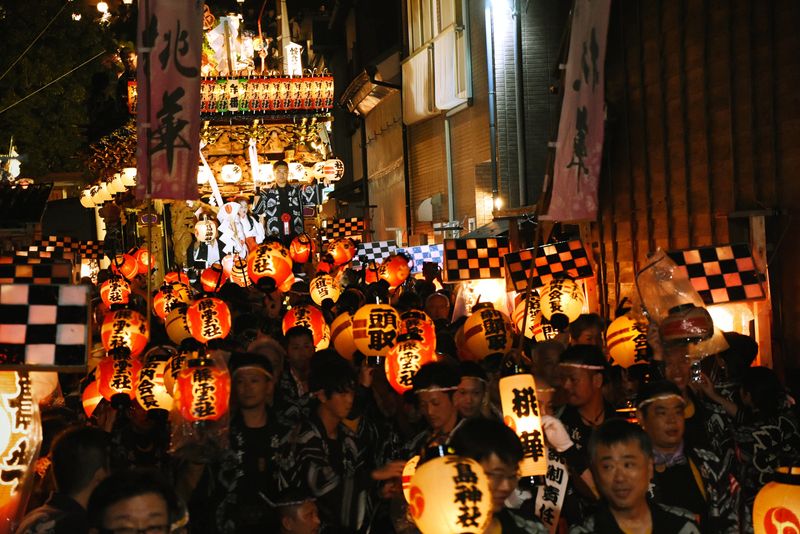
The town of Morimachi in Shizuoka Prefecture, central Japan, became wrapped in festival fervor over a weekend in November, as the community put on a feisty festival display belaying its rural setting.
<For festival highlights and more from life in this part of rural Japan ... >
I’ve never known what appears to be an entire community be so entirely consumed by its local festival but this is what we saw play out during the annual Enshu Mori no Matsuri (遠州森のまつり), over the course of the first weekend in November.
The signs were there though. In a meet and greet with the town mayor, Yasuo Ota, at his office on the eve of the festival, we asked about the kind of spectator numbers they were expecting.
“Around 20,000. But there are no official numbers,” came the response. “Of course, people come to see the festival, but more than just watching, this festival is about participation.”
Morimachi, a town in southwestern Shizuoka Prefecture, centering on the Ota River and flanked on three sides by mountains, itself has a population of around 18,000 which probably highlights the core nature of the festival -- this isn’t tourist spectacle (although it could be, and it certainly is a spectacle), it’s something to be a part of. A festival for the people perhaps, but really the people are the festival.
There appear to be few people around on our first night in town, however, as we source our evening meal. Mayor Ota recommended a couple of places at which to eat, but each was followed by the qualifier, “if they’re opening tonight.” Most eyes here are on tomorrow's festival it seems.
Things aren't always this quiet in Morimachi -- a town which garnered mention by the celebrated Japanese artist Hokusai and appears to have hit its stride in the middle of the Edo period when the propensity for things to catch fire saw the Akibasan faith prosper.
Pilgrims, looking to fend off the flames, journeyed along the Akiha Kaido to Hongu Akiha Jinja, a shrine in nearby Hamamatsu, to offer their respects to a deity believed to protect against fire. Morimachi became a popular rest stop en route and the fuzzy annals of history suggest that our festival was already active around this time.
On festival’s eve, haunting lamps in the center of town cast shadows against the walls of buildings from the period, giving a sense of old glories (and lending credence to the town’s adopted moniker of “Little Kyoto”) while in the near distance travelers of today race by, taking an alternative route, the elevated Shin-Tomei Expressway.
Friday, day one of the Enshu Mori no Matsuri, and we’re in place in the grounds of Mishima Jinja, a small shrine sitting on a bluff between the Ota River and the old streets of town, for the festival’s opening ceremony.
On this bright, crisp autumn day there’s little in the ceremonial proceedings to belay the fervor (albeit a controlled kind) set to consume the town come nightfall, save for the words of the mayor who addresses an audience of solemn dignitaries and young men already red-faced with drink, with a stern call for the festival to proceed safely, without incident.
Such remarks might sound like the default address of a school principal on sports day but here they carry the weight of history.
The Enshu Mori no Matsuri is not without reason, it seems, referred to as a “kenka matsuri,” a quarrelsome festival. While the history is hard to pin down, the festival’s fiery reputation has been traced back by some observers to incidents of violence during celebrations in 1863, the third year of the Bunkyū era.
Actual causes are clouded in speculation but the festival’s past reputation for violent incident appears to have persisted for some years with suggestions it lead police to call a halt to the pulling of the festival’s yatai (floats) and organizers to declare that there should be no further incident during the celebrations.
Whatever the extent to which old reputations are justified, the strong sentiment towards no further incident appears to be echoed by the mayor today.
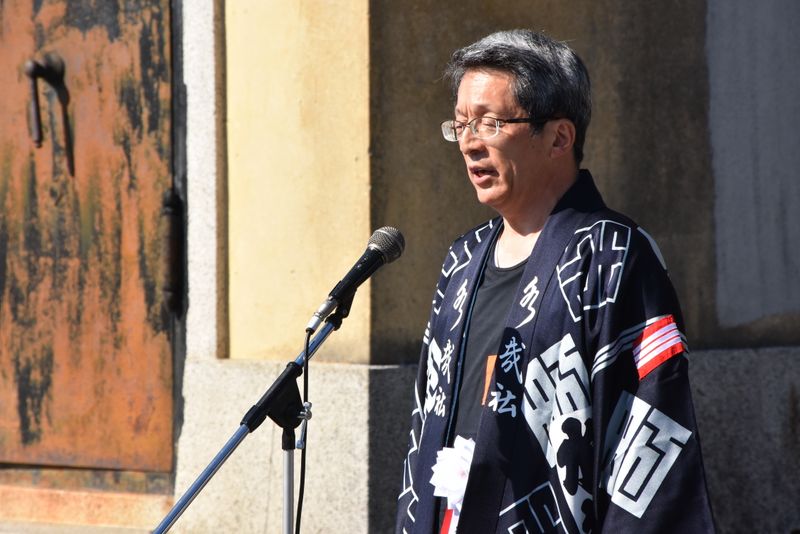
(Mayor of Morimachi, Yasuo Ota, addresses town residents during the festival's opening)
Festival spirits however, already seem to be high and feisty. Perched at the top of the precipitous steps leading to the Mishima Jinja grounds, we watch as men from town pull a procession of yatai through the narrow streets below, drunk with drink and revery, and swinging the heavy things to and fro to the guttural cries of “Yoisora!” Perhaps they’ll be spent come the evening. (Which turns out not to be the case, emphatically.)
14 yatai, each headed up by a town association, transport the spectacle of the Enshu Mori no Matsuri throughout the weekend. Their fine decorative flourishes and Dickensian lanterns are in stark contrast to a giant lumbering structure as tall as some buildings in town, perched on two wheels that takes a team of men, drunk enough to numb the pain of the pulling, to drag them and their flute-playing, drum-beating passengers through town and between the two shrines that form festival HQ, the Mishima and Kanamori shrines.
These days it’s the yatai that are likely to be prime suspect behind any unwanted festival incident, and our guide, Tatsuo Muramatsu, head of the town’s Settlement Promotion Division, warms us about the dangers the combination of crowded narrow streets and swaying yatai present.
“You see these bits of red cloth?” says Muramatsu, pointing to the deep red material hanging from either side of a beautiful wooden building as we find a gap between parading floats on a tight street in the center of town. “This is the owners of the building telling people controlling the yatai to keep their distance.”
Given the ornate structure, it’s probably a good shout. Moments later a yatai up ahead takes pause to swing dramatically towards an open-fronted store where booze and food is being handed out.
At one point, a young lad full of bravado and drink lunges out into its path. Whistles are blown, voices are raised, the yatai comes to an admirably quick halt, and our youth is shoved firmly back to the side of the street amidst howls of comical protest.
This wasn’t the only close encounter with the yatai we would see during the festival, but it highlighted how quickly people here can switch from merriment to safety mode, apparently having taken the mayor’s words to heart.
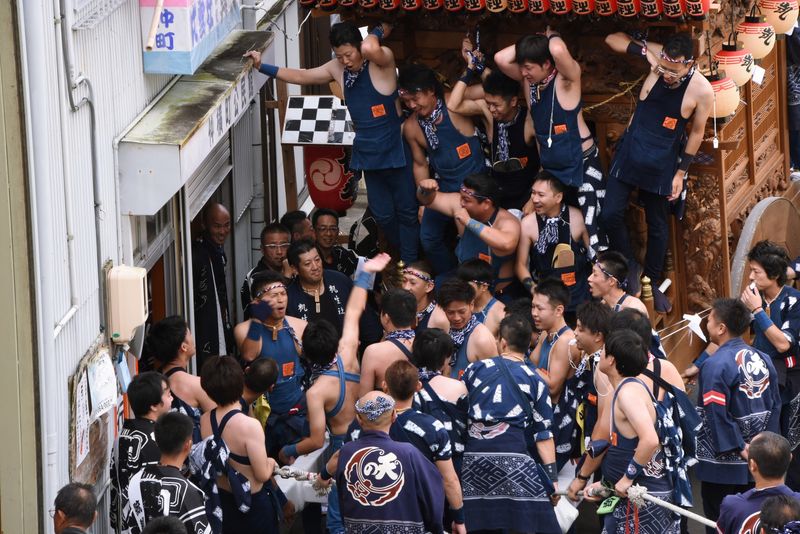
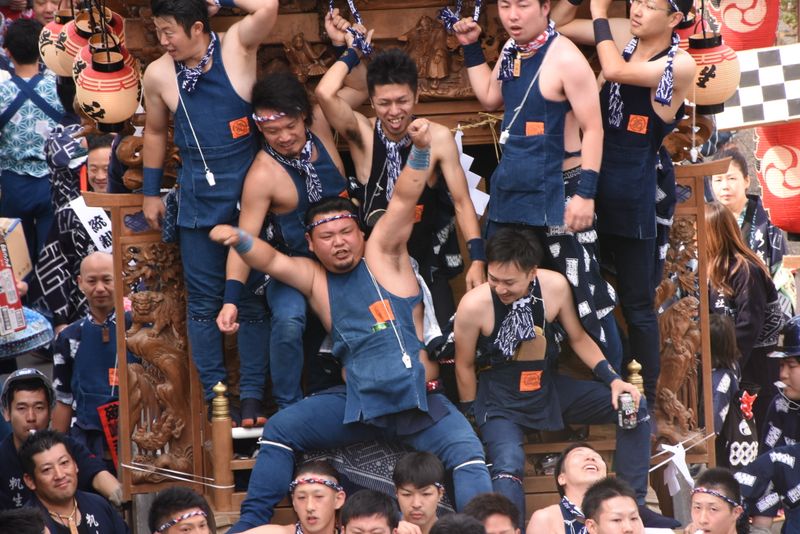
The festival reaches its climax on the Sunday night when the yatai are charged in their final duty with something called Maikogaeshi, “the returning of the maiko.”
Late afternoon and the old Morimachi streets are dotted with stalls selling the typical festival food, drink, and incongruous superhero masks. The scene is filling with people (Where were they the other day?), almost all in traditional festival dress, and I feel more conspicuous for being in my civvies than I do for being a foreigner.
Aside from the odd whisper of “Ah! Gaijin da!” though, most people here pay us scant heed with minds focused on little more than the celebrations.
“The festival is in our DNA,” explains a Japanese lady who grew up in Morimachi but has spent the last 40 years living in California. Back in Japan during the festival she seems happy to be reunited with childhood friends and to reflect on the festival as we sit eating finger food and drinking liquor in the home of a local resident.
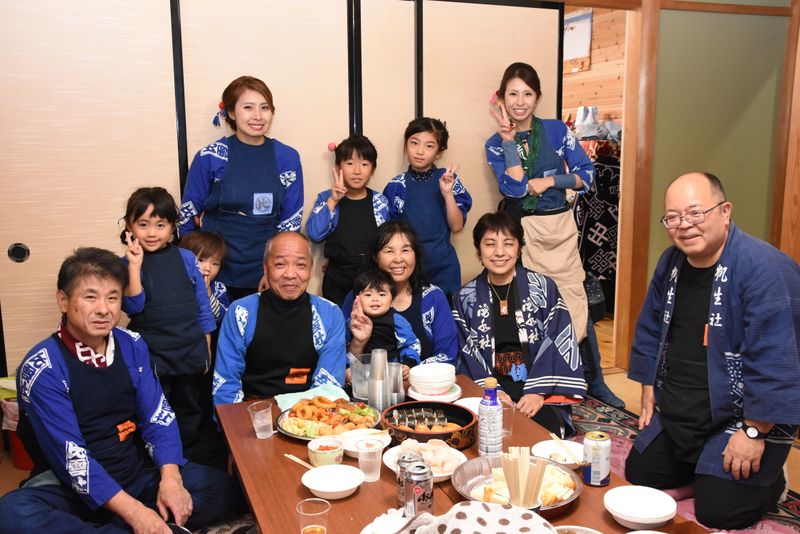
(Festival food and drink at the home of a local family, our guide Tatsuo Muramatsu on the far right)
“Many people come back just for the festival,” she continues. “A lot of them keep homes in the area. Once it’s over though, the town will look very different.”
Festival returnees would seem to explain why there are so many young people on the streets here, something that comes as a surprise amidst Japan’s increasing urbanization and aging population that has left many rural communities behind to fend for themselves.
People return though, because the festival is the most important event of the year, surpassing even New Year’s festivities, which tend to be limited to close family.
“During the festival, people open up their homes and serve food and drink. Everyone is welcome.”
At that moment a young man looms at the window of our prime bit of festival real estate, dressed in pink and with long morbid hair, he cuts an unusual figure but quickly disappears into the growing crowds gathering on the street immediately out front.
“This man is a Japan matsuri fanatic. He’s quite famous,” we’re told. “He travels around Japan going to all the festivals.”
The young man’s presence in town is perhaps further evidence then that the Enshu Mori no Matsuri is a Japanese festival of some significance. And if more evidence were needed, it might be that few people in town seem concerned about the small matter of work.
“Of course, work is important but it isn’t even a consideration during the festival,” explains our guide Muramatsu, readying himself for the challenge of negotiating us around the Maikogaeshi, the festival at its feverish and feisty peak.
Maiko, children dedicated to bugaku (traditional Japanese court dance), are a key part of the festival proceedings, dedicating dances at the festival shrines over the course of the three days.
On the final day, the maiko are returned to their families, carried down the steps of Mishima Shrine and transported by yatai to their home, feet never having touched the ground.
“In the past there were so many children eligible to be maiko that they were selected by a kind of lottery, or maybe if a child’s family had suffered some hardship that year,” says the head of Morimachi’s Board of Education, Mr. Hinaji, about the process of selecting maiko who, traditionally, would be girls, seven or eight years old, and for whom it was a great honor to be selected.
The number of children to pick from in Morimachi is getting lower, we’re told, and even after having expanded the age and gender of eligibility to all elementary school students (six to twelve years old) residents are having to think outside of the box, or go without altogether.
At this year’s festival, one yatai group has an adult performing maiko duties, while another is simply making do without.
The thinning pool of potential maiko seems to be met with a matter-of-fact shrug rather than any great lament. And anyway, there’s the current festival to be enjoyed, something which the people of Morimachi have been looking forward to all year. Concerns about the future, as with work, can be put on hold for now.
From the second floor balcony of the house we can see how the streets have filled as yatai are transported to the beat of drums and the flourishes of flutes to the foot of Mishima Shrine, ready to pick up their special passengers. The ethereal glow of lanterns and a softening dark combine with the liquor making it seem as if the once lumbering yatai are now floating by, the people perched on top almost at eye level.
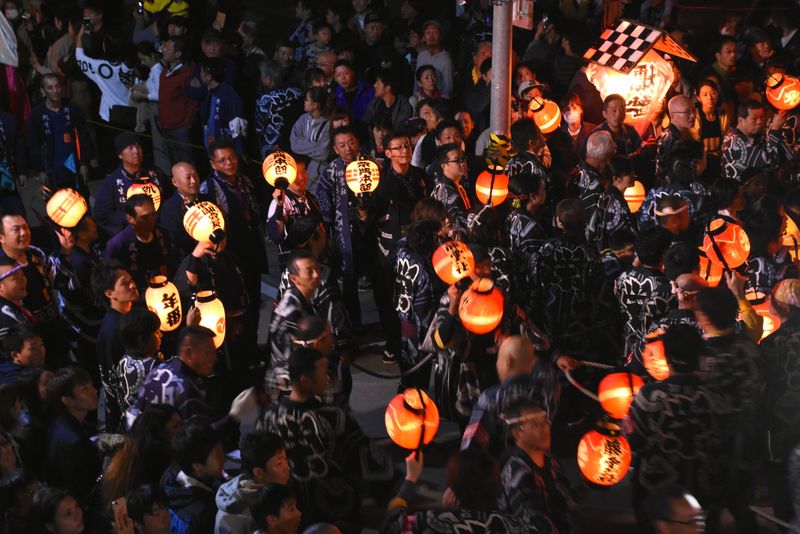
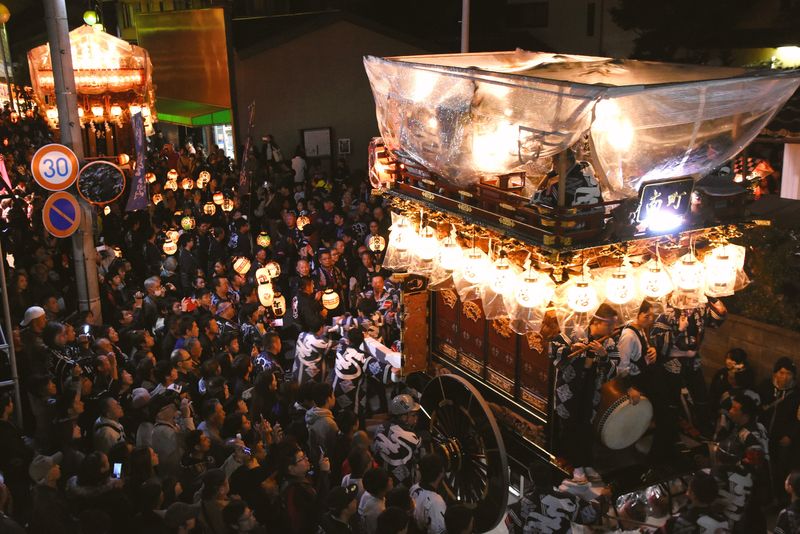
Back at street level, Muramatsu guides us through the shadowy throngs to be in position to see the maiko carried out from the entrance of the shrine.
It’s a quite an enchanting spectacle, filled with moments of rare festival quiet, as lantern bearing men part either side of the entrance thoroughfare, in the dark and in heavy anticipation of their (mostly) young charge.
Dressed in white and red, with a floral headdress and face painted white, the maiko emerges to cries of “Banzai!” before being lifted and carried out of the grounds. Bearers keep rhythm to the kind of chant that brings me out in goosebumps as we approach the steps, the foot of which is packed with people straining for a look at the maiko.
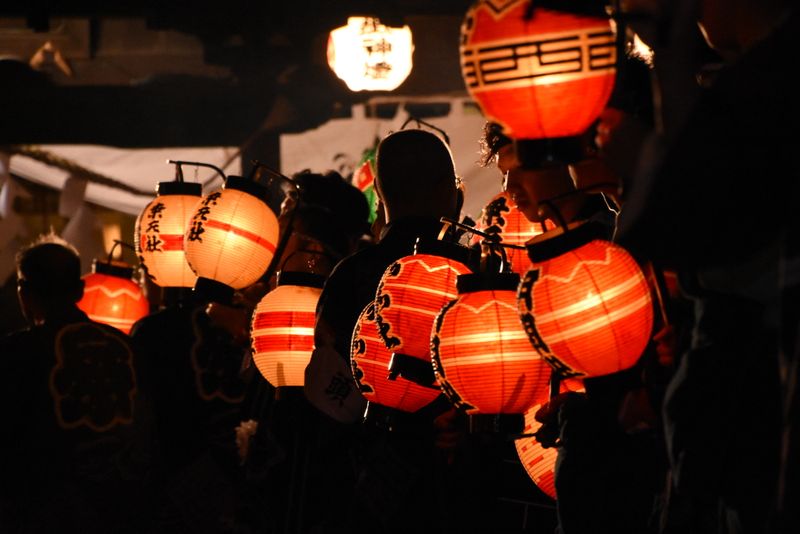
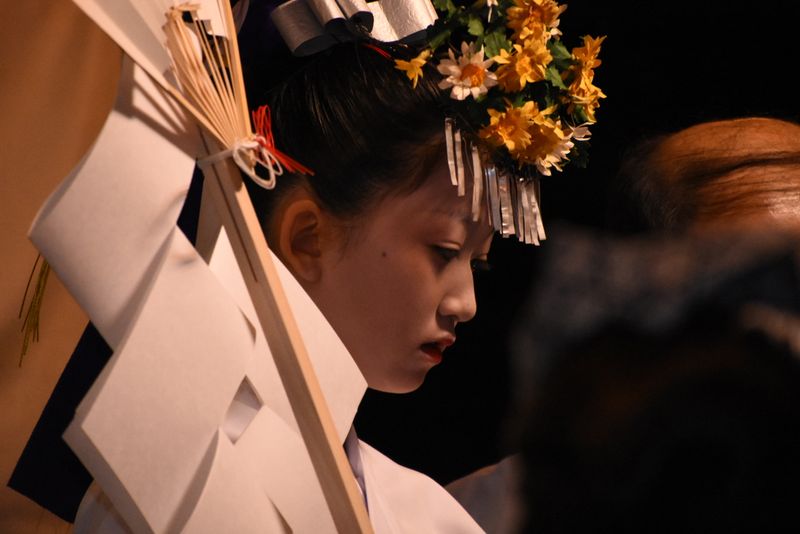
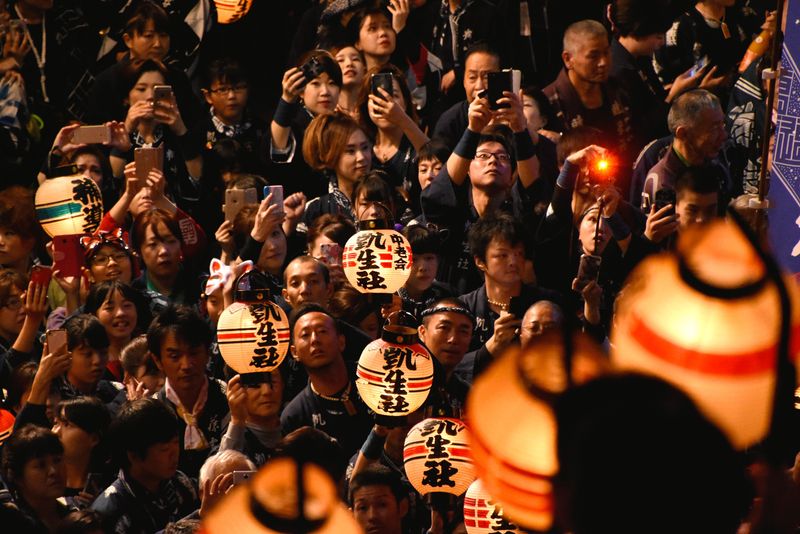
It’s another rush through the crowded streets so we can be ready to witness the final maiko being delivered to proud parents at their local store.
I’m tucked into a corner right out front as the yatai swings back and forth, getting closer to its destination, the maiko, a young boy this time, holding firm in center stage. It’s a frantic scene and we’re pressed back into whatever space is available to press back into (very little) each time the yatai surges towards us.
I’m shooting (wobbly) film at the same time as trying to guard a young lad who doesn’t seem as concerned as I am about just how close the brutal weight of the yatai is. In fact, he’s reaching out to push the thing back and appears delighted to do so.
It’s all part of the rough ceremonial discipline though and with a final and emphatic surge some of us are left with nowhere to go but to stumble into the store just as the yatai is set in place to deliver its passenger to proud parents, their feet never having touched the ground.
It’s a touching moment of poise and control, and the perfect punctuation to the fervor that preceded it.
Our final day in town, and we’re once again heading out to eat. From outside the bars and restaurants we can hear the excited chatter coming from end of festival parties accompanied by the now familiar festival drums and flutes. It's the sound of people reluctant to let go, so they don’t.
Back at the house we had asked how people in Morimachi deal with getting back into the regular routine after riding on such festival high.
“Yes, people are sad, so they just start planning for the next festival right away,” came the response.
As well they might, for this is the Japanese festival at its intoxicating best, an intimate, at times feisty, experience liable to linger long in the minds of anyone who partakes. And besides, for the people of Morimachi, it’s in the DNA.
for more about rural life in shizuoka & Japan
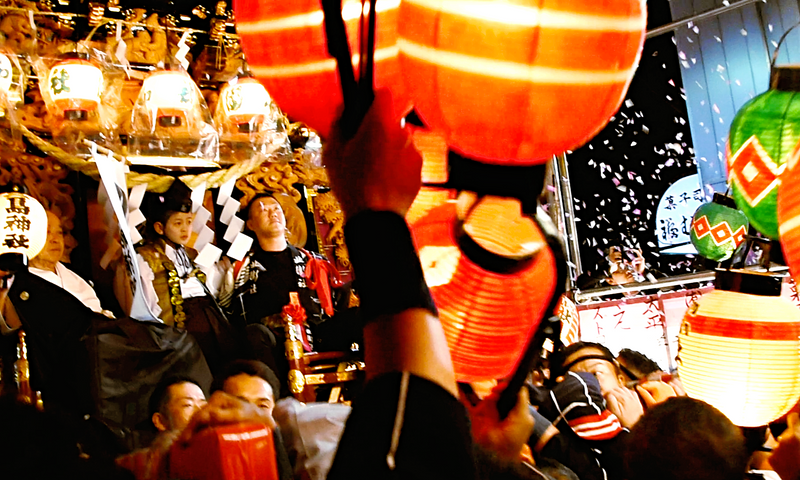



3 Comments
andikurnia
on Nov 22
interesting event, and what a great photos
Tsuneko2295
on Nov 28
Thank you so much for such a nice article with beautiful pictures!! I was born and raised in my beloved Mori-Machi, I live in Kobe now though. Your expression about the festival was amazingly fantastic!! I was moved a lot!!
City-Cost
on Dec 1
@andikurnia , @Tsuneko2295 Thanks for the comments and kind words about the article. It was a great festival!